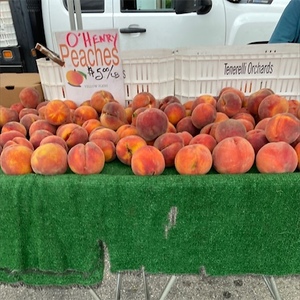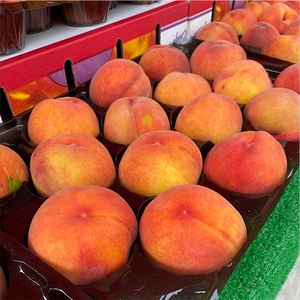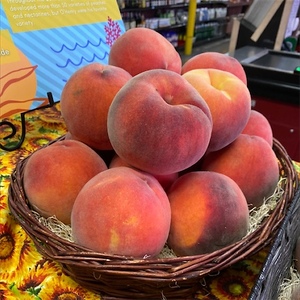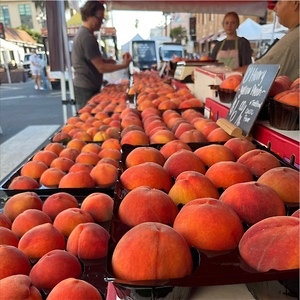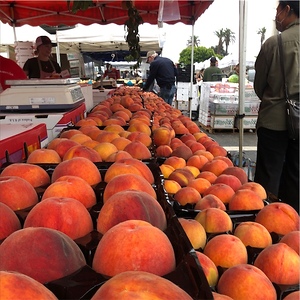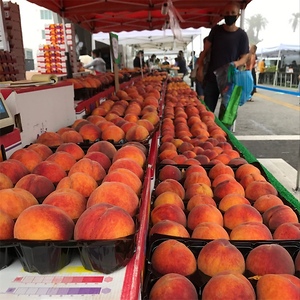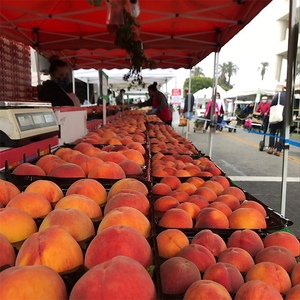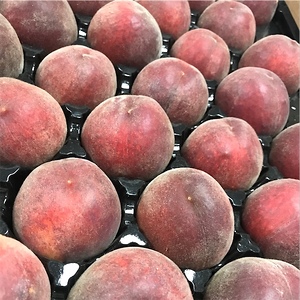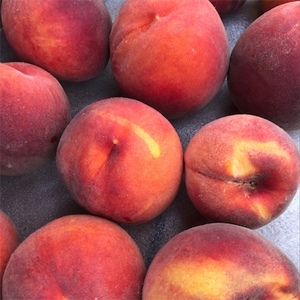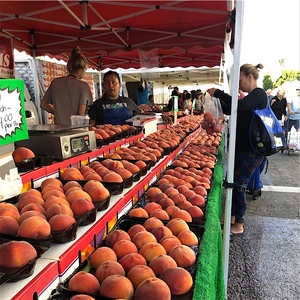

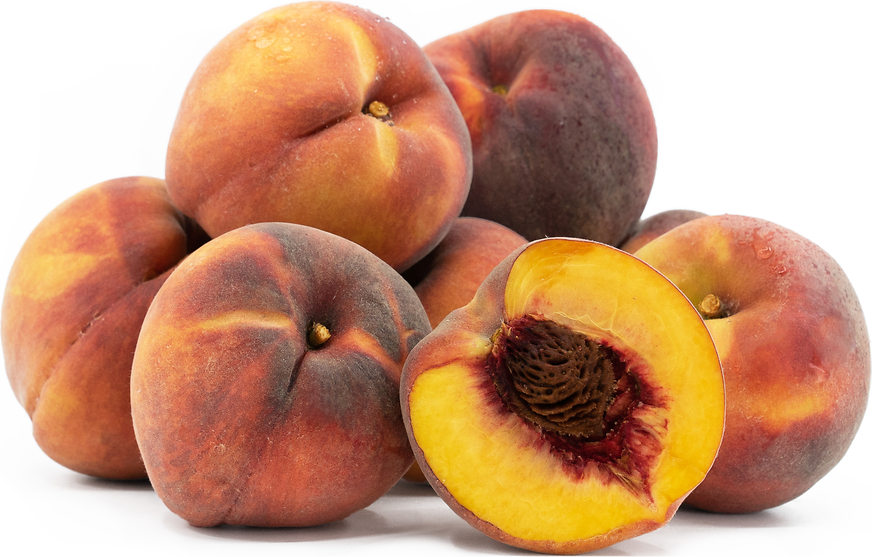
O'Henry Peaches
Estimated Inventory, cs : 0
Description/Taste
O'Henry peaches are medium to large fruits, averaging 6 to 8 centimeters in diameter, and are round to slightly lopsided in shape with a distinct point on the non-stem end. The fruit’s skin is thin, taut, and velvety, covered in a light coating of fuzz, and showcases a signature orange-yellow base almost entirely enveloped in a dark red blush. Underneath the surface, the flesh is dense, smooth, golden yellow with red striations, and aqueous, encasing a freestone brown pit loosely adhered in the center. The fruit’s flesh also has a characteristic firm texture, even when ripe, creating a subtly crunchy consistency. Ripe O’Henry peaches will develop a slight give when pressed and will emit an aromatic, fresh scent. The peaches contain a sweet, fruity, and mildly herbal flavor balanced with acidity, creating a tart and tangy aftertaste. In addition to the fruits, O’Henry peach trees also produce show pink flowers in the spring.
Seasons/Availability
O'Henry peaches are available in the late summer through early fall.
Current Facts
O’Henry peaches, botanically classified as Prunus persica, are a late-season variety belonging to the Rosaceae family. The fruits grow on deciduous trees that can reach 4 to 6 meters in height, bearing fruit in their third year, and were developed in California in the late 20th century as one of the first almost entirely red-skinned peaches. O’Henry peaches were one of the most popular California peach varieties in the 1980s and have remained a commercially cultivated favorite in the present day, highly valued for their sweet flavor, self-pollinating nature, productive habits, hardiness in transport, and extended storage capabilities. The fruits are slow-ripening and can be held on the tree for a long period, allowing the fruits to develop complex flavorings and the growers to harvest in succession, lengthening the fruit’s season. O’Henry peaches are also one of the last varieties to arrive in commercial markets at the end of the season in California and are grown in both commercial orchards and home gardens. The cultivar has contributed to peach breeding, being a part of the lineages of augustprince, scarletprince, and early augustprince varieties.
Nutritional Value
O’Henry peaches are an excellent source of antioxidants, including vitamin C, to strengthen the immune system, reduce inflammation, and protect the body against external environmental aggressors. The peaches are also a good source of vitamin A to maintain healthy organ functioning, fiber to regulate the digestive tract, potassium to balance fluid levels within the body, and other bioactive compounds including phenolic acids, anthocyanins, flavonoids, and procyanidins.
Applications
O’Henry peaches have a balanced, sweet-tart flavor well suited for fresh and cooked preparations. The fruits can be consumed straight, out of hand, discarding the pit, or they can be sliced into fruit bowls, used as a topping over pancakes, cereal, yogurt, and ice cream, or tossed into green salads. O’Henry peaches can also be added into smoothies, chopped into salsa, used to flavor fruit punches and cocktails, or frozen and blended into sorbet. The fruits can sometimes be sprinkled with salt to counter their sweetness and consumed as a snack, or they can be topped with ricotta cheese and honey. In addition to fresh preparations, O’Henry peaches hold up well to light cooking and can be grilled as a savory-sweet dish. The peaches can also be poached, sauteed, or baked in both sweet and savory recipes, simmered into jams and jellies, or incorporated into baked goods such as tarts, cakes, scones, pies, crisps, and cobblers. O’Henry peaches pair well with brown sugar, vanilla, honey, spices such as cinnamon, nutmeg, and allspice, herbs including basil, mint, and rosemary, ginger, berries, fennel, and other stone fruits. Whole, unwashed O’Henry peaches can be stored at room temperature for a couple of days, and once ripe, they will keep 3 to 4 days when stored in the refrigerator. The fruits can also be dehydrated, canned, or frozen for extended use.
Ethnic/Cultural Info
Grant Merrill was a private breeder based in Red Bluff, Northern California. Throughout the 20th century, Merrill developed more than 50 varieties of peaches and nectarines and was often likened by his peers to famed horticulturist Luther Burbank. Merrill sought to create peach varieties with improved characteristics such as extended storage capabilities, attractive coloring, and pleasant, fresh-eating flavors. O’Henry peaches were the first peach that exhibited almost entirely red skin and was highly favored for their nearly fuzz-less nature. The cultivar was regarded as a commercial breakthrough and spurred a new wave of peach varieties in the late 20th century. In the 1970s and 1980s, approximately forty percent of the peaches grown in California were created from Merrill-produced varieties. It has also been reported that O’Henry peaches were Merrill’s favorite variety. Merrill passed away in 1973, but his legacy has not been forgotten, as many of his peach varieties are still grown in commercial markets in the modern day. His hometown of Red Bluff also built a memorial to honor his fruitful career.
Geography/History
O’Henry peaches were developed by breeder Grant Merrill in Central California. The variety was believed to have been created from an open-pollinated seedling of Merrill bonanza peaches, possibly crossed with an unknown nectarine, and was released to commercial growers in 1968. The cultivar quickly rose in popularity, and by the mid-1980s, O’Henry peaches were one of the top varieties produced in California. Today O’Henry peaches are still one of the top ten cultivars grown commercially and privately in California and are also planted in Washington, Utah, and Idaho. Outside of California and the Pacific Northwest, O’Henry peaches are produced on a smaller scale in Canada and along the East Coast and in the Southern United States. When in season, O’Henry peaches can be found through farmer’s markets, specialty distributors, and select grocers.
Recipe Ideas
Recipes that include O'Henry Peaches. One



